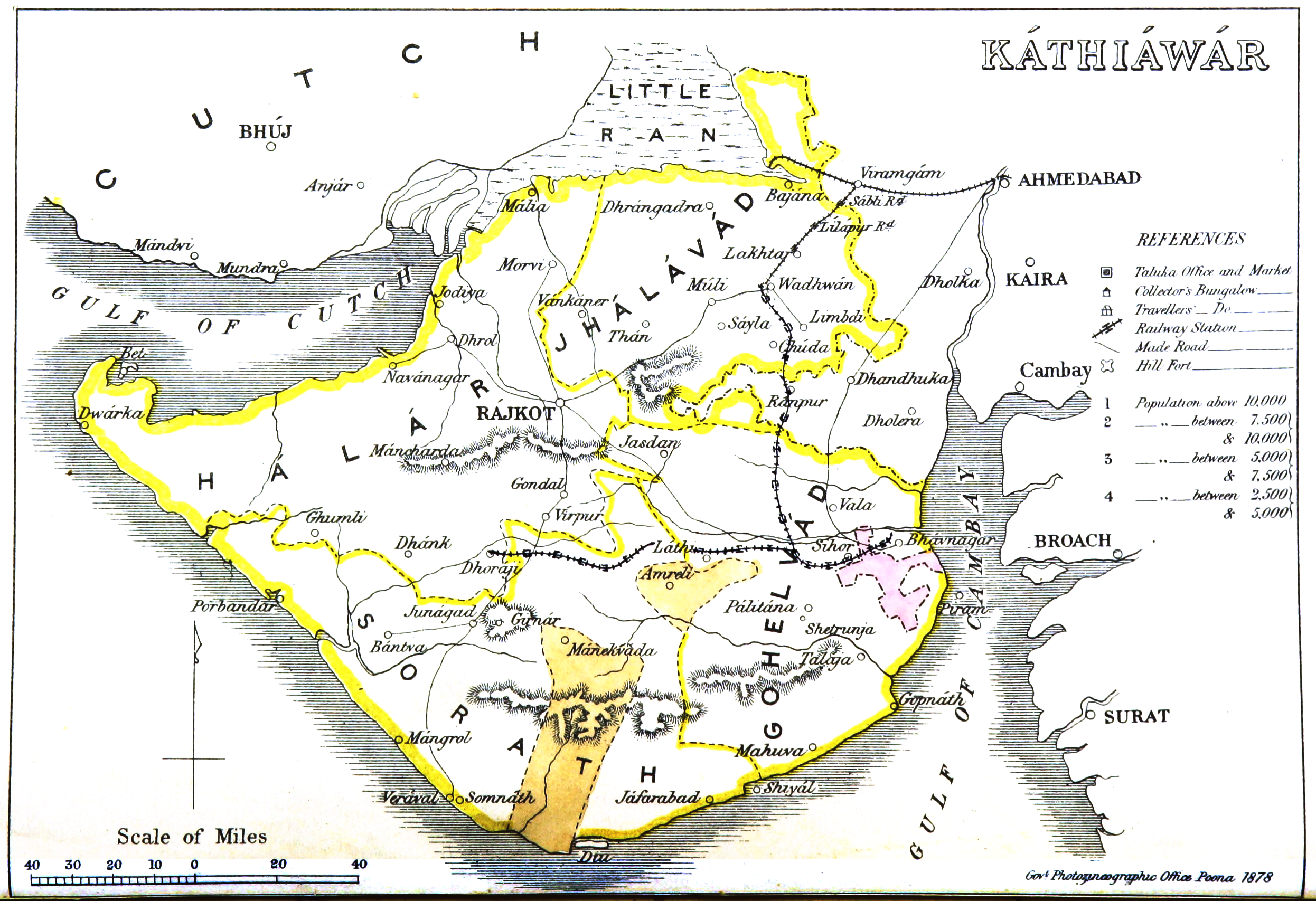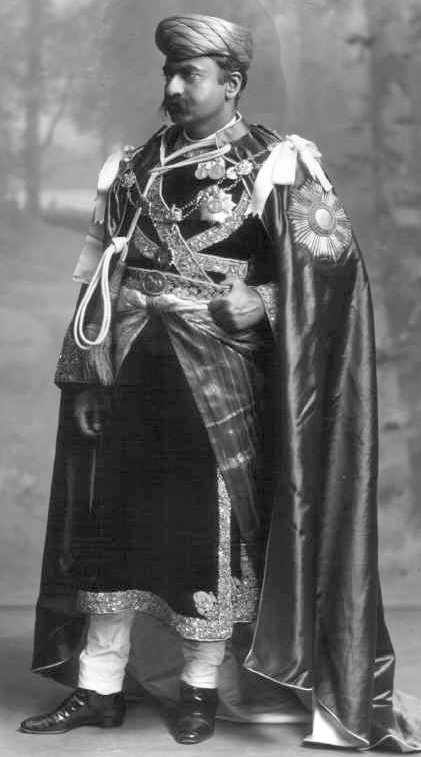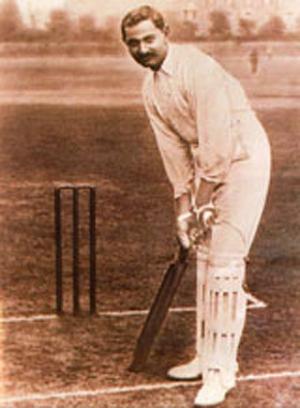|
Kathiawar Agency
The Kathiawar Agency, on the Kathiawar peninsula in the western part of the Indian subcontinent, was a political unit of some 200 small princely states under the suzerainty of the Bombay Presidency of British India. The agency's headquarters were at Rajkot, the town where the Political Agent used to reside. He reported to the Political Department office at Bombay, Bombay Presidency. History The agency was formed in 1822, after the princely states in the area became British protectorates. The region was severely affected by the famine of 1899–1900. Between 1891 and 1901, the population of the states covered by the Agency decreased by 15 per cent, largely due to the results of the famine. On 10 October 1924, the agency was abolished and merged into the Western India States Agency, which had three subdivisions:The Indian Year Book, Volume 11 by Bennett, Coleman & Company, 1924,pp:151–152 * Eastern Kathiawar Agency (from 1926 onwards) * Western Kathiawar Agency (from 1926 ... [...More Info...] [...Related Items...] OR: [Wikipedia] [Google] [Baidu] |
British India
The provinces of India, earlier presidencies of British India and still earlier, presidency towns, were the administrative divisions of British governance on the Indian subcontinent. Collectively, they have been called British India. In one form or another, they existed between 1612 and 1947, conventionally divided into three historical periods: *Between 1612 and 1757 the East India Company set up Factory (trading post), factories (trading posts) in several locations, mostly in coastal India, with the consent of the Mughal emperors, Maratha Empire or local rulers. Its rivals were the merchant trading companies of Portugal, Denmark, the Netherlands, and France. By the mid-18th century, three ''presidency towns'': Madras, Bombay and Calcutta, had grown in size. *During the period of Company rule in India (1757–1858), the company gradually acquired sovereignty over large parts of India, now called "presidencies". However, it also increasingly came under British government over ... [...More Info...] [...Related Items...] OR: [Wikipedia] [Google] [Baidu] |
Banas Kantha Agency
Palanpur Agency, also spelled Pahlunpore Agency, was a political agency or collection of princely states in British India, within the Gujarat Division of Bombay Presidency. In 1933, the native states of the Mahi Kantha Agency, except for Danta State, Danta, were included in the Western India States Agency. The agency, headquartered at Palanpur, oversaw some 17 princely states and estates in the area, encompassing an area of 6393 square miles (16,558 km2) and a population, in 1901, of 467,271. History and hierarchy Established in 1819, the Agency was under the political control of the Bombay Presidency until 10 October 1924, from which date it was under the Western India States Agency, which depended directly from the Governor General of India. Of the three Political Agencies in the Northern Division of the Bombay Presidency, the next in importance to Kathiawar Agency, Kathiawar was the Palanpur Agency, established in 1819. The designation of Palanpur Agency was changed to B ... [...More Info...] [...Related Items...] OR: [Wikipedia] [Google] [Baidu] |
Gaekwar
The Gaekwads of Baroda (also spelled as Gaikwads, Guicowars, Gaekwars) (IAST: ''Gāyakavāḍa'') are a Hindu Maratha dynasty origin of the former Maratha Empire and its subsequent Princely States. A dynasty belonging to this clan ruled the princely state of Baroda in western India from the early 18th century until 1947. The ruling prince was known as the Maharaja Gaekwad of Baroda. With the city of Baroda (Vadodara) as its capital, during the British Raj its relations with the British were managed by the Baroda Residency. It was one of the largest and wealthiest princely states existing alongside British India, with wealth coming from the lucrative cotton business as well as rice, wheat and sugar production. Early history The Gaekwad rule of Baroda began when the Maratha general Pilaji Rao Gaekwad conquered the city from the Mughal Empire in 1721. The Gaekwads were granted the city as a Jagir by Chhatrapati Shahu I, the Chhatrapati of the Maratha empire. In their early year ... [...More Info...] [...Related Items...] OR: [Wikipedia] [Google] [Baidu] |
Indian Rupee
The Indian rupee ( symbol: ₹; code: INR) is the official currency in the republic of India. The rupee is subdivided into 100 ''paise'' (singular: ''paisa''), though as of 2022, coins of denomination of 1 rupee are the lowest value in use whereas 2000 rupees is the highest. The issuance of the currency is controlled by the Reserve Bank of India. The Reserve Bank manages currency in India and derives its role in currency management on the basis of the Reserve Bank of India Act, 1934. Etymology The immediate precursor of the rupee is the ''rūpiya''—the silver coin weighing 178 grains minted in northern India by first Sher Shah Suri during his brief rule between 1540 and 1545 and adopted and standardized later by the Mughal Empire. The weight remained unchanged well beyond the end of the Mughals until the 20th century. Though Pāṇini mentions (), it is unclear whether he was referring to coinage. ''Arthashastra'', written by Chanakya, prime minister to the first Maurya ... [...More Info...] [...Related Items...] OR: [Wikipedia] [Google] [Baidu] |
Gondal, India
Gondal is a city of about 115,000 residents and a municipality of about 175,000 in the Rajkot district of the Indian state of Gujarat. Gondal State was one of the eight first-class princely states of Kathiawar Agency, Bombay Presidency in British India. Ruled by a Hindu Rajput dynasty of the Jadeja clan, the capital of the state was Gondal town. History Gondal is mentioned in texts like ''Ain-i-Akbari'' (written in the reign of Akbar) and ''Mirat-i-Ahmadi'' as a Vaghela state in Sorath ( Saurashtra). The Gondal State in Kathiawar Agency was founded in 1634 by Thakore Shri Kumbhoji I Meramanji from the Jadeja dynasty, who received Ardoi and other villages from his father Meramanji. Kumbhoki's fourth descendant, Kumbhoji IV, increased the size of the state by acquiring parganas such as Dhoraji, Upleta, and Sarai. [...More Info...] [...Related Items...] OR: [Wikipedia] [Google] [Baidu] |
Rajkumar College, Rajkot
The Rajkumar College (or RKC) in Rajkot, Gujarat is one of the oldest K-12 institutions in India. RKC has a 26-acre (105,000 m²) campus in Rajkot. History The foundation stone of Rajkumar College was laid in 1868. The institution was designed by Colonel Keatinge and was formally opened by the Governor of Bombay, H. B. Sir Seymour Fitzgerald, in 1870. The college was founded for the education of the princely order by the princes and chiefs of Kathiawad for their sons and relations. In 1938, on the initiative of its founding members, the college became a public school (private school in American terms). The college is a founding member of the Indian Public Schools Conference and a member of the Round Square conference of schools, a worldwide association of more than 60 schools that allows students to travel between schools and tour the country or do community service. In 2001 the college opened its doors to girls, in what has been a boys' bastion for over a century. The scho ... [...More Info...] [...Related Items...] OR: [Wikipedia] [Google] [Baidu] |
Governor-General Of India
The Governor-General of India (1773–1950, from 1858 to 1947 the Viceroy and Governor-General of India, commonly shortened to Viceroy of India) was the representative of the monarch of the United Kingdom and after Indian independence in 1947, the representative of the British monarch. The office was created in 1773, with the title of Governor-General of the Presidency of Fort William. The officer had direct control only over Fort William but supervised other East India Company officials in India. Complete authority over all of British territory in the Indian subcontinent was granted in 1833, and the official came to be known as the "Governor-General of India". In 1858, because of the Indian Rebellion the previous year, the territories and assets of the East India Company came under the direct control of the British Crown; as a consequence, the Company rule in India was succeeded by the British Raj. The governor-general (now also the Viceroy) headed the central governmen ... [...More Info...] [...Related Items...] OR: [Wikipedia] [Google] [Baidu] |
Porbandar State
Porbandar State was a princely state during the British Raj ruled by Jethwa dynasty. It was one of the few princely states with a coastline. The capital of state was the harbour town of Porbandar. Some other important towns of this state were Bhanvad, Chhaya, Ranpar, and Shrinagar. Earlier Shrinagar served as the capital of Jethwas, then Ghumli served as the capital, but was lost to the Jadejas, however, architectural heritage built by them still stands at Ghumli. During the British Raj, the state covered an area of , encompassing 106 villages and a population, in 1921, of over 100,000 people. It enjoyed a revenue of Rs. 21,00,000/-. History In 1193 Porbandar State was founded by an ancestral ruler expelled from Morvi State. In 1307 the state was renamed 'Ranpur' and in 1574 it was renamed 'Chhaya'. Finally in 1785 the state reverted to the name Porbandar. On 5 December 1809 it became a British protectorate and between 1886 and 15 September 1900 the state was administere ... [...More Info...] [...Related Items...] OR: [Wikipedia] [Google] [Baidu] |
Nawanagar State
Nawanagar was an Indian princely state in the historical Halar region, located on the southern shores of the Gulf of Kutch. It was ruled by the Jadeja Rajput dynasty and became the part of newly formed India. The city is now known as Jamnagar. It had an area of and a population estimated at 336,779 in 1901. Its rulers, who use the title of "Jam Saheb" are of the same clan as the Cutch State, Rao of Kutch. They were entitled to a 13-gun salute. The state flag was a rectangular red flag with a white elephant, near and facing the hoist. During the British Raj, British, the state was part of the Kathiawar Agency, within the Gujarat Division of Bombay Presidency. The state had a pearl fishery and much of its wealth came from this. Nawanagar is also famous for its late ruler Jam Saheb Ranjitsinhji (died 1933), who was a famous cricket player at Cambridge in England before his accession to the throne. History Nawanagar was founded in 1540 by Jam Rawal, Jam Sri Rawalji, a descendant ... [...More Info...] [...Related Items...] OR: [Wikipedia] [Google] [Baidu] |
Morvi State
Morvi State, also spelled as Morvee State or Morbi State, was a princely salute state in the historical Halar ''prant'' (district) of Kathiawar during the British Raj. The town of Morvi (Morbi), Gujarat, was its capital. The Kotwals of the royal palace of Morvi were Talpada Kolis of Radhavanaj village of Kheda district. The rulers of the princely state belonged to the Jadeja dynasty of Rajputs. The state's last ruler signed the instrument of accession to the Dominion of India on 15 February 1948. History Morvi was founded as a princely state around 1698 by Kanyoji when the heir apparent of Cutch State fled Bhuj with his mother after his father Ravaji was murdered and the throne was seized by his uncle Pragmalji I. It became a British protectorate in 1807. The state was in the colonial sway of the Kathiawar Agency of the Bombay Presidency. In 1943, with the implementation of the 'attachment scheme', Morvi State enlarged its territory by an additional 310 km2 wi ... [...More Info...] [...Related Items...] OR: [Wikipedia] [Google] [Baidu] |
Junagadh State
Junagarh or Junagadh ( ur, ) was a princely state in Gujarat ruled by the Muslim Babi dynasty in British India, until its integration into the Union of India in 1948. History Muhammad Sher Khan Babai was the founder of the Babi Pashtun dynasty of Junagarh in 1654. His descendants, the Babi Nawabs of Junagarh, conquered large territories in southern Saurashtra. However, during the collapse of the Mughal Empire, the Babis became involved in a struggle with the Gaekwad dynasty of the Maratha Empire over control of Gujarat during the reign of the local Mohammad Mahabat Khanji I. Mohammad Khan Bahadur Khanji I declared independence from the Mughal governor of Gujarat subah, and founded the state of Junagarh in 1730. This allowed the Babi to retain sovereignty of Junagarh and other princely states. During the reign of his heir Junagarh was a tributary to the Maratha Empire, until it came under British suzerainty in 1807 under Mohammad Hamid Khanji I, following the Second Ang ... [...More Info...] [...Related Items...] OR: [Wikipedia] [Google] [Baidu] |
Jafarabad State
Jafarabad, or Jafrabad State, was a tributary princely state in India during the British Raj. It was a dependency of the Nawab of Janjira State and located in the Kathiawar Peninsula on the Gujarat coast. The state had formerly been part of the Baroda Agency and later of the Kathiawar Agency of the Bombay Presidency. See also *Janjira State *Political integration of India *Western India States Agency The Western India States Agency (WISA) was one of the agencies of British India. This agency was formed on 10 October 1924 as a part of the implementation of the Montague Chelmsford report on constitutional reforms. It was formed by merging the ... References {{coord, 20.8667, N, 71.3667, E, region:IN_type:landmark_source:kolossus-svwiki, display=title Bombay Presidency Muslim princely states of India Amreli district States and territories established in the 1650s 1650s establishments in India 1948 disestablishments in India Princely states of Gujarat ... [...More Info...] [...Related Items...] OR: [Wikipedia] [Google] [Baidu] |




.jpg)
.jpg)